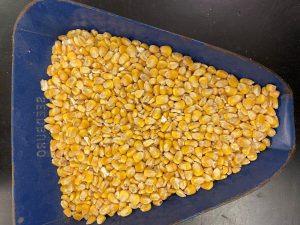by aschortinghouse | Mar 31, 2023
Introduction
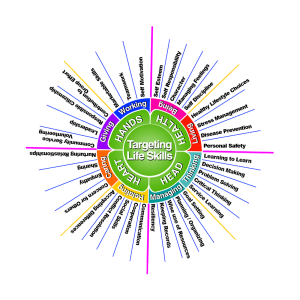
Figure 1: 4-H Life Skills Wheel Sources: (Hendricks, 1998) and (Norman & Jordan, 2018)
The goal of a 4-H program is for youth to learn about and develop life skills that will help them, in both the short term and long term, become contributors to their communities (Norman & Jordan, 2018). Life skills are the competencies or traits that relate to helping individuals’ function and navigate their lives.
When we begin planning 4-H programs with the end in mind, life skills are one of the considerations we should focus on. These skills should be identified during the planning process at the same time you are planning the objectives for each meeting. The life skills wheel illustrated in figure one serves as a tool to help visualize the most common life skills 4-H programs focus on. When we identify these skills, we can intentionally plan our programs to provide experiences that are specific and challenging without being overwhelming.
Often, we use projects and special interests as a hook to teach youth life skills. While some subjects are best suited to developing certain life skills, there are skills to be learned and developed no matter the exact subject being taught.
Getting Started
On the life skills wheel, all the life skills are categorized under the headings of head, heart, hands, and health which relates back to the 4-H pledge. By identifying the skills, you are targeting then planning activities to help you build those skills, you can build impactful programs that will continue to build on each other.
Let’s look at a scenario. We are working with a group of club officers at a training day preparing for the new 4-H year. The objectives for the meeting are for officers to learn their roles and for the youth learn more about each other so they are more comfortable working together. From here, we need to identify the skills we are hoping to build.
When you look at the life skills wheel there are numerous skills which could fit and be developed during this training. While some skills are built passively through experience, identifying three to five skills will help us identify activities and focuses that align with our objectives.
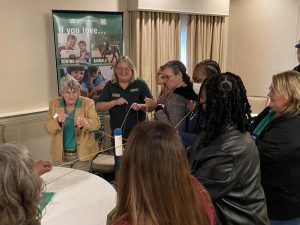
Picture 1: Volunteers participating in the bull ring activity at the 2023 NWD Volunteer Forum in Destin, Florida.
For this scenario, if we identify teamwork, problem-solving, communication, and planning/organizing as the life skills we intend to build, we need to identify activities that will build these skills. When working with activities we need to keep in mind that we need time for the do, reflect, apply model. So, once we do the activity, we need time for reflection, and a discussion on how we could apply what we have learned in the future.
If we look at this scenario a little bit closer, you will notice that some skills can be built during the same activity. An example of this would be if we were to use the bull ring activity, which has a tennis ball balanced on a ring by multiple strings are held by multiple participants standing in a circle as demonstrated in picture one, participants are going to use a bunch of life skills including communication, teamwork, problem-solving, and even planning. All these skills are necessary to successfully move the ball from point A to point B without dropping the ball. It is the intentional reflection and future application discussion of the skills that pulls in the impact and development of a skill beyond the passive learning that occurs.
Conclusion
4-H projects and meetings are an ideal environment for passive learning of life skills. However, it is the intentional planning of club and project leaders that results in active life skill development. So, as you are planning your next meeting, start with the end in mind. Identify your objectives and the life skills you want to develop, then intentionally plan activities and discussions which will lead youth through active thoughts and practice of the skills you are focusing on.
Resources
Hendricks, P. (1998). Developing youth curriculum using the targeting life skills model: Incorporating developmentally appropriate learning opportunities to assess impact of life skill development.
Norman, M., & Jordan, J. (2018, July 30). Targeting Life Skills in 4-H. https://edis.ifas.ufl.edu/publication/4H242

by bestevez | Mar 10, 2023
Public speaking is a beneficial and important project that all 4-H youth can do, but many youth and adults are shy about getting started. 4-H provides several “low-risk” opportunities for youth to develop confident communication skills. The necessary skills associated with being a good public speaker have always been an important part of the 4-H experience and 4-H clubs are encouraged to foster a positive, learning-oriented environment for youth regarding this subject. Helping young people develop a growth mindset toward their communication skills is one of the top priorities of the Florida 4-H Program.
Why Public Speaking?
Learning to be a good public speaker is something that will be useful throughout a 4-H member’s lifetime. Members who feel comfortable speaking in front of others have a greater sense of self-confidence, a feeling of respect for themselves and others, and generally have a solid feeling of accomplishment. Good public speakers are more apt to do well in a job interview or a presentation in college or in a future career.
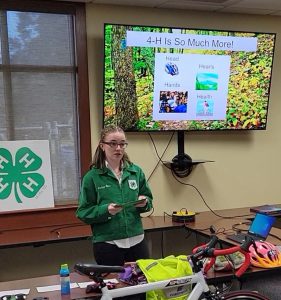
Escambia County 4-H member Madelyn gives a demo on bicycle safety at 4-H County Events.
The 4-H public speaking program provides opportunities for 4-H members to learn skills in articulating a message. The objectives are to:
- Develop leadership talents and work toward character development and effective citizenship;
- Recognize the value of obtaining all information on a given topic;
- Encourage careful organization of material to be presented;
- Develop a pleasing personal appearance before an audience;
- Acquire the ability to speak convincingly in public.
There is no “right” or “best” way to speak, except to be yourself and to show you are interested in your topic. It is only when you are natural that you communicate your real self—and all speeches need the personality you can give them.
Here are some suggestions to help 4-H youth (and adults) be at their best when giving a speech:
- Get plenty of rest before you meet your audience. Do not eat much before you speak—this can keep the butterflies in your stomach from bothering you too much;
- If you are nervous, breathe deeply and slowly several times just before you are introduced. Relax your arms, legs, and body as much as possible;
- When you are introduced, walk briskly to the lectern, smile, and look at the audience as though you are glad to be there;
- Stand tall—don’t lean on the table, podium, or lectern;
- Be confident from the beginning—first impressions are important. Be sure you speak loudly enough to be heard by all.

Escambia County 4-H member Reid gives a speech on Scorpions at 4-H County Events
Florida 4-H offers many different types of public speaking opportunities for youth to participate in (and adults to judge!). These opportunities can vary from leading a pledge, to giving a demonstration about your pet, to speaking on stage in front of hundreds of people.
Basic public speaking opportunities in 4-H:
- Becoming a club officer;
- Giving a committee report at a meeting;
- Leading pledges;
- Making a motion.
Advanced public speaking opportunities in 4-H:
- Demonstration or illustrated talk at a club meeting;
- County and District Events presentation;
- Health and Safety talk or skit;
- Food preparation talk;
- Speaking to civic groups and local government about 4-H;
- Teaching a 4-H workshop or clinic;
- Camp counseling.
The signature Spring 4-H speaking event is 4-H County Events hosted by individual county 4-H programs. County Events provide youth an opportunity to share their projects through friendly competition. Youth can prepare for 4-H County Events in their 4-H clubs by giving demonstrations and talks to practice this valuable life skill. Contact your local 4-H Agent to learn more about 4-H County Events being offered in your county.
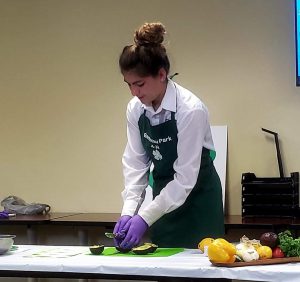
Escambia County 4-H member Tucker gives a food prep demonstration at 4-H County Events
At 4-H County Events, Cloverbuds (ages 5-7) may participate but are NOT judged. They will receive feedback and a participation ribbon. Juniors (ages 8-10), Intermediates (ages 11-13), and seniors (ages 14+) are judged in their respective age divisions. 4-H County Events consists of the following communication venues:
- A Demonstration or Illustrated Talk is a “show and tell” presentation in a specific curriculum area, using posters, props, and/or PowerPoint to communicate your presentation content.
- The Public Speaking program is designed to give 4-H members experience in the preparation and delivery of a 4-H related speech. This contest requires 4-H members to recognize, organize, and present information on a given topic. The timed speech must be orderly and thorough. 4-H members must acquire the ability to speak convincingly in public, expressing ideas effectively with poise and confidence
- The 4-H Share-the-Fun program is designed to help 4_H members discover their talents, develop them, and have opportunities to share those gifts with others.
- The Florida 4-H Photography program encourages self-expression and allows youth to demonstrate skills learned in the area of photography, including the use of photographic equipment and editing tools.
- The Graphic Design Program gives 4-H members an opportunity to use their creativity and artistic ability to promote their project areas or 4-H program. 4-H members are encouraged to develop their visual communication skills by also identifying locations to display their created materials as a means to communicate with external audiences about the 4-H program.
In 4-H, youth learn by doing, and the best way to learn about giving a speech is to get up in front of others and give one. To always “Make the Best, Better,” encourage youth to give a speech at their next 4-H meeting, in their classroom, or wherever an audience is gathered. The goal of becoming a better public speaker starts with that first speech.

Escambia County 4-H member Gracie gives a speech about her 4-H career at 4-H County Events.
by jgl1 | Mar 3, 2023
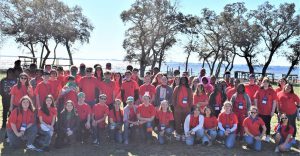 4-H teens from across the Florida Panhandle convened at Camp Timpoochee February 17-19 for our Northwest Teen Retreat. This event is planned for teens by a committee of teens and adult advisors. The youth selected the theme of “Lights, Camera. Action”. This leadership event is a time for youth to participate in workshops and explore sparks related to different 4-H project areas.
4-H teens from across the Florida Panhandle convened at Camp Timpoochee February 17-19 for our Northwest Teen Retreat. This event is planned for teens by a committee of teens and adult advisors. The youth selected the theme of “Lights, Camera. Action”. This leadership event is a time for youth to participate in workshops and explore sparks related to different 4-H project areas.
The event kicked off with a pep rally and district games. This was followed by open recreation and camp tours. On Saturday, the youth participated in a Mindfulness workshop, as well as a workshop to learn about 4-H awards and scholarships. All youth took part in a service project, Boggy Bears. Teens cut out and sewed cloth teddy bears to donate to disabled youth attending Camp Boggy Creek next summer. 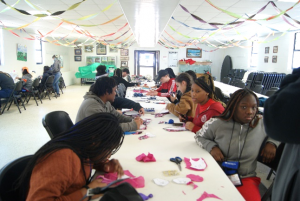
The youth had a choice of several fun shops to learn about 4-H projects, contests, and opportunities. Fishing, Tailgating, Dance, Cake Decorating, and Forensic Entomology workshops were offered to help youth explore their sparks. The event ended with a Red Carpet Dance and slideshow developed by Jefferson County teens. One youth shared:
My favorite part of Teen Retreat is getting to meet other 4-Hers from across the panhandle of Florida.

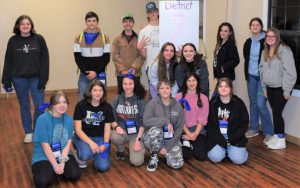

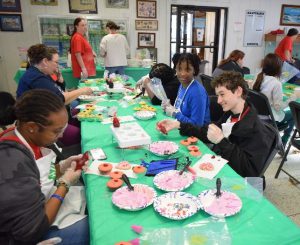 For more information about the 4-H Northwest Florida District Teen Retreat, or to join the committee to plan next year’s event, contact your local UF IFAS Extension Office. Additional events for Teens to explore careers and sparks include iLead, 4-H University, and 3rd Executive Board.
For more information about the 4-H Northwest Florida District Teen Retreat, or to join the committee to plan next year’s event, contact your local UF IFAS Extension Office. Additional events for Teens to explore careers and sparks include iLead, 4-H University, and 3rd Executive Board.
by Marie Arick | Feb 24, 2023
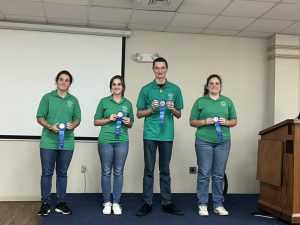
Escambia County’s 1st place Food Challenge Team
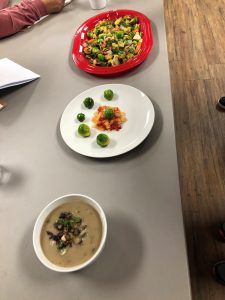
Judging table display of culinary creations. Top, Liberty’s, center Escambia’s intermediate, bottom Escambia’s senior.
The Northwest District 4-H Food Challenge took place on January 7, 2023, and the results were phenomenal! This new competition challenges youth to work as teams of no less than two or more than four, and practice critical thinking, open communication, and presentation skills. Presentations are to include the knowledge and skills youth have learned through the project such as kitchen safety, food safety, cooking techniques, recipe creation, and how they worked together. But that is not all, additionally, teams are using a set of specific cooking supplies, a mystery ingredient, a specific dish category (main dish, side dish, appetizer, or healthy dessert), and a set amount of 4-H money to spend at the challenge grocery store. The entire competition allows 40 minutes for youth to put all of this into practice. Escambia County entered a senior and intermediate team while Liberty County entered an intermediate team into the inaugural competition.
Escambia County’s senior team, dubbed O Crepe and the Spice Girls consisted of Alan Bray-Crews, Laney Clarke, Ryan Clarke, and Aubrie Dillon, who were presented with portabella mushrooms for their mystery ingredient with the category of the main dish. The team produced an excellent mushroom soup as their main dish. The dish along with their well-prepared presentation earned them a place in the Florida 4-H State Food Challenge competition at the Florida State Fair in Tampa on February 18.
The two intermediate teams’ mystery ingredient was Brussel sprouts and the side dish category. The Flaming Clovers of Escambia County consisted of Chloe Bray-Crews, Brian Brewster, Charli McClendon, and Kayla Weaver with alternate member Scott Weaver on hand. The Culinary Criminals represented Liberty County made up of Harper Holt, Jansen Capers, Isabella Ransom, and Lexi Ford. The two teams created uniquely different dishes and presentations. While the Escambia team received the first-place ribbon, Liberty County’s team came in a very close second place. Escambia’s intermediate team also earned a place at the Florida State Food Challenge competition at the Florida State Fair in Tampa!
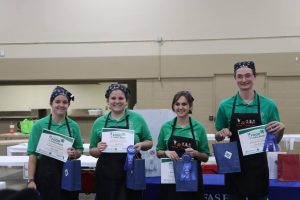
photo credit D. Clarke
O Crepe and the Spice Girls
With both Escambia teams representing the Northwest District at the state competition, it was exhilarating to watch the kids interact and quiz one another while awaiting the competition to begin. Seniors were given a red bell pepper as the mystery ingredient with the category of side dish and intermediates were given a tangerine for their mystery ingredient with the category of healthy dessert. Again, Escambia County dominated and secured first place in both age categories. The first-place senior team at the Florida State Fair, Escambia County’s O Crepe and the Spice Girls, is eligible to compete in the National 4-H Food Challenge at the State Fair of Texas in Dallas this fall.
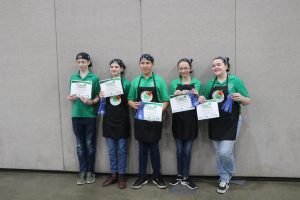
photo credit D. Clarke
Flaming Clovers
This new 4-H opportunity has been embraced in several counties thus far and will continue to grow. This project promotes practical life skills youth will use for the rest of their lives. If your child is interested in food and nutrition and/or healthy lifestyles projects, contact your local 4-H Agent to explore project opportunities.
A special thanks to Escambia County’s volunteer leader, Linda Crews, who has embraced this competition and has worked with these youth to truly make the best better, and to Mr. Dave Clarke for sharing state event photos.
For more information about the 4-H Food Challenge, visit our webpage. The 4-H Food Challenge would be a fun program for your next club meeting. Download the youth guide, team captain guide, and guide for hosting a food challenge.
by Heather Kent | Dec 9, 2022
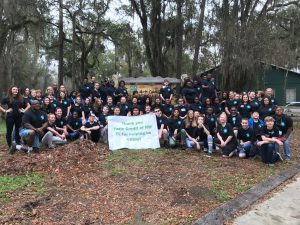 Our youth planning committee has been hard at work planning the 2023 Northwest Teen Retreat. This year’s theme is “Lights, Camera, Action!” and promises to be a fun-filled weekend of learning and friendship. The retreat will be held February 17-19 at 4-H Camp Timpoochee. Registration is open to all youth ages 12-18 in 4Honline. This event is planned for teens, by teens, and is designed to help youth develop and practice workforce-ready skills. Over the weekend, youth also have the opportunity to explore different 4-H project areas. Here’s a run-down of the agenda, and what to expect:
Our youth planning committee has been hard at work planning the 2023 Northwest Teen Retreat. This year’s theme is “Lights, Camera, Action!” and promises to be a fun-filled weekend of learning and friendship. The retreat will be held February 17-19 at 4-H Camp Timpoochee. Registration is open to all youth ages 12-18 in 4Honline. This event is planned for teens, by teens, and is designed to help youth develop and practice workforce-ready skills. Over the weekend, youth also have the opportunity to explore different 4-H project areas. Here’s a run-down of the agenda, and what to expect:
| Friday Night |
After check-in, enjoy some pizza, tour the camp, and participate in District games. This year youth will have the opportunity to try to beat the adults! |
| Saturday Morning |
After breakfast, youth will have the opportunity to participate in a service project, learn about 4-H awards and scholarships, and how to deal with different personalities. |
| Saturday Afternoon |
After lunch, youth will select a fun shop to learn more about a 4-H project area. This year, our teen planning committee selected the following:
1. Grilling- learn about fire safety, food safety, and how to win a scholarship in the 4-H Tailgating Contest
2. Sports Fishing- Camp Timpoochee is a great place for fishing. Learn some angler skills and how to participate in the 4-H Sports Fishing Tournament and Skill a thon.
3. Cake Decorating- If you love those baking shows, then you will love this session! Practice decorating a cake with icing like a pro.
4. Dance- Get your exercise will learning some fun new line dances, as well as a few favorites.
5. Forensic Science- This session is about forensic entomology. Work as a team to solve the murder of a Florida Black Bear- a mystery solved by science! |
| Saturday Evening |
After dinner, walk the Red Carpet Saturday and dance the night away. |
| Sunday Morning |
As soon as breakfast is over, pack up and head home. |
Thanks to generous sponsors, the registration fee is only $120 per youth and includes cabin accommodations, meals, workshop supplies, and a t-shirt. Your county 4-H program may be able to offer additional discounts or scholarships, so check with your local 4-H office before registering in 4Honline. Download this handy packing list to your phone.
If you have any questions, please reach out to your local UF IFAS Extension Office. Registration is open from December 16 through January 31st.
by Evie Hunter | Oct 21, 2022
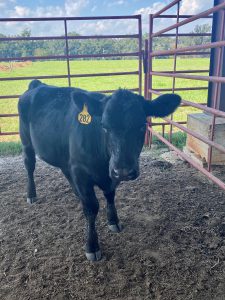 Happy fair season everyone! Fairs aren’t just about rides and food but also about participating in showing livestock, entering exhibits, and competing in judging contests. Judging contests are a great way for youth to explore a topic they are interested in, and practice decision-making and critical thinking skills. One of the most popular judging contests is agriculture judging. There is an agricultural judging contest online and at the North Florida Fair.
Happy fair season everyone! Fairs aren’t just about rides and food but also about participating in showing livestock, entering exhibits, and competing in judging contests. Judging contests are a great way for youth to explore a topic they are interested in, and practice decision-making and critical thinking skills. One of the most popular judging contests is agriculture judging. There is an agricultural judging contest online and at the North Florida Fair.
The Florida 4-H Virtual Ag Judging Contest will take place on October 27th at 6:00 pm EST on Zoom and it is free! There will be a training prior to the contest to allow 4-H youth an opportunity to learn about each topic before participating in the contest. The training will be held on October 25th at 6:00 pm EST on zoom. This contest is great for 4-H youth to learn how to judge steers, dairy cows, poultry, swine, hay, grain, peanuts, and tomatoes. There will also be questions on tool identification, weed identification, and soil samples. To participate in this contest youth must be 4-H age 8-18 and will need to register in 4-H Online. If you have any questions about this event, please email Evie Blount (ecb1224@ufl.edu) or Chris Decubellis (cdecube@ufl.edu). We had so much fun creating this contest virtually and are super excited for youth all over the state to participate! This is our 3rd year doing this contest and we are happy to see it grow!
The North Florida Fair Ag Judging Contest will take place on November 12th at the fairgrounds in Tallahassee, Florida. This contest will be covering judging steers, heifers, poultry, hay, and grains. This contest is for youth 4-H age 8-18 that are interested in learning how judge agriculture. To participate in this contest youth must be register in 4-H Online and contact your 4-H Agent to sign up. If you have any questions about this event, please email Robbie Jones r.jones1@ufl.edu or Evie Blount (ecb1224@ufl.edu).
If you are new to agriculture judging, below are some resources to help you prepare:
